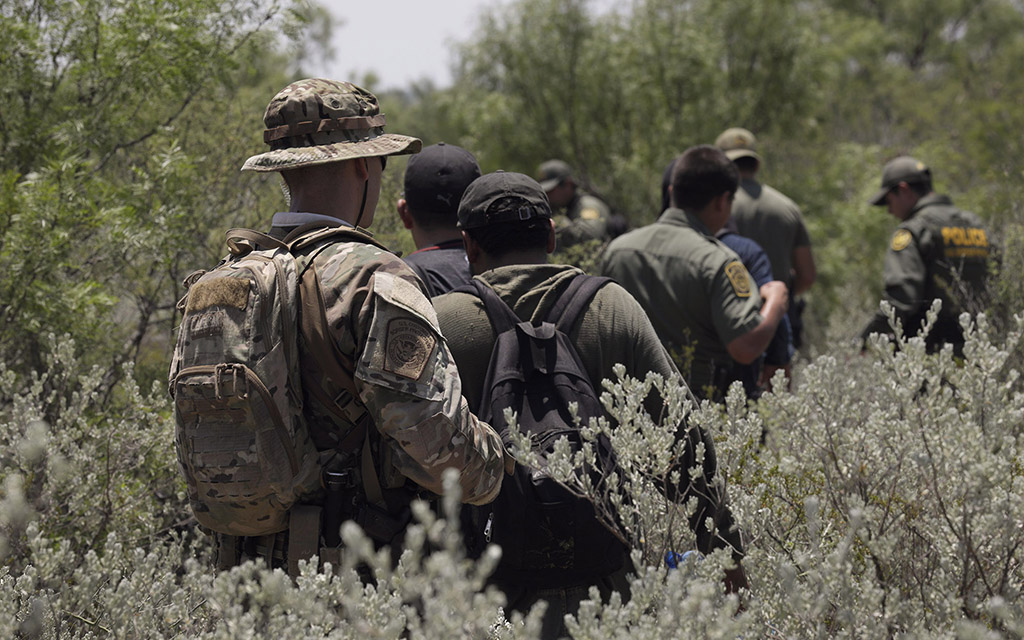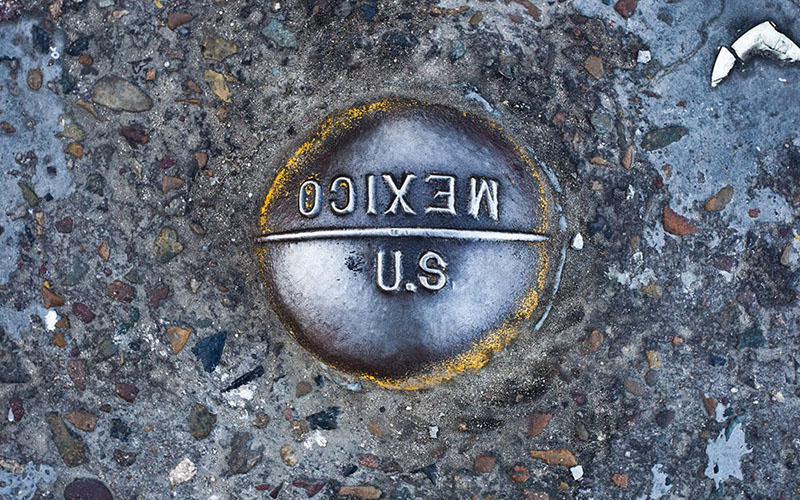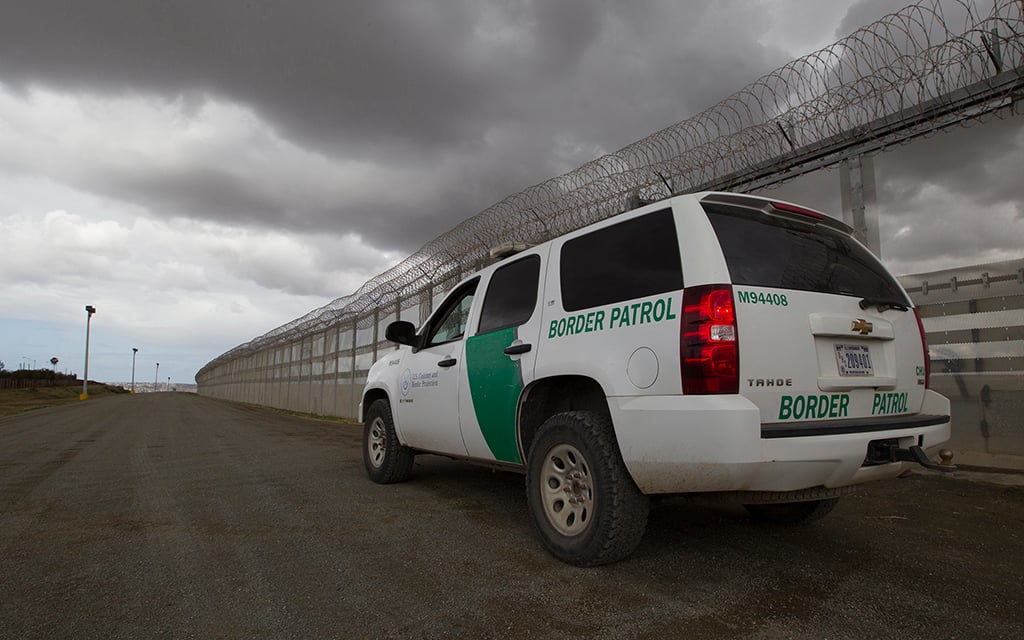
Use-of-force reports have surged in recent years, along with border encounters. Customs and Border Protection says it is committed to investigating such incidents, but advocates are unimpressed. Here, Border Patrol agents detain four migrants stopped near the Texas border in a 2019 photo. (Photo by Glenn Fawcett/Customs and Border Protection)
WASHINGTON – Use-of-force incidents by Customs and Border Protection officers have nearly doubled in the past five years, from 593 in fiscal 2019 to 1,090 in fiscal 2023, with the vast majority occurring at the southern border.
The rise in use of force comes at a time when migrant encounters have surged to historic highs, nearing 2.5 million in fiscal 2023. There were 1,082 use-of-force incidents reported that year, less than 0.05% of the total encounters.
A spokesperson said CBP is committed to investigating all such incidents and that “maintaining the public’s trust is vital to our mission.”
“CBP is committed to being a leader in law enforcement accountability and transparency by providing multiple ways to report incidents as well as timely, accurate and appropriate information regarding CBP-related deaths, use of force incidents and other critical incidents resulting in serious injuries,” the spokesperson said.
But advocates are calling for more oversight. They took their case to the United Nations in October, where a delegation from the Southern Border Communities Coalition and victims argued that the use of force violates the International Covenant on Civil and Political Rights.
“The U.S. was instrumental in building the human rights system around the world and yet, has actually signed very few treaties obligating it to protect human rights at home,” said Ricky Garza, an attorney with the SBCC.
“The International Covenant on Civil and Political Rights is one of a very small number of treaties that the U.S. has actually signed and ratified by the Senate and made part of domestic law,” said Garza, who presented a report highlighting CBP’s use-of-force instances for the 2023 review of U.S. compliance with the ICCPR.
One of those testifying before the U.N. Human Rights Committee in Geneva, Switzerland, was Marisol Garcia Alcántara, a Mexican national who said she was shot in the head by a CBP officer in Nogales while illegally crossing the border with others in June 2021. She was hit when an officer opened fire on the car she was in.
“The ambulance picked me up and took me to a hospital … and was told that it was a miracle that I was alive, since I had been shot in the head and that I had to be rushed to the hospital in (Phoenix) Arizona,” she said recently through a translator.
She said she had emergency brain surgery and rested for a day before being transferred Saturday to the Florence Correctional Center, where she spent 22 days before being deported and barred from reentering the United States for 20 years.
Alcántara said she was only given ibuprofen or acetaminophen while at the center, and was denied access to a translator, despite notices there that “all migrants had the right to a translator.”
“I asked the immigration police officer that I wanted to speak to a translator to ask why they were deporting me for so many years,” but said she was told, “No Spanish.”
She knew she had been shot in the head, but said she knew nothing about her medical condition. “The only two times they spoke to me (at the center) was to ask me to sign my statement papers, which I never did, because I asked for a translator and a lawyer, and they told me no.
“I left the United States without any medical records or any papers of any kind,” Alcántara said.

The vast majority of use-of-force incidents reported by Customs and Border Protection have occurred at the southern border. (Photo by Josh Denmark/U.S. Customs and Border Protection)
With the assistance of the Border Patrol Victim’s Network, Alcántara got legal help and was referred to a neurologist who “told me what my medical condition was like. A lawyer from Arizona supported me by getting me the medical records.”
With the help of the network, she has filed for a civil lawsuit, suing for damages and justice for her mistreatment.
Asked for comment on Alcántara’s case, CBP said the incident is being investigated by its Office of Professional Responsibility, which will forward its findings to the National Use of Force Review Board. That board’s findings will be posted publicly when its review is complete.
The statement also noted that when use of force incidents do occur, “investigations are conducted independently, thoroughly, with proper oversight, and CBP holds employees accountable when policies are violated.”
Alcántara’s experience is an extreme example of force used by border officers. But the SBCC said it is important for victims to be heard.
“We sent a whole delegation to Geneva, Switzerland, to advocate on behalf of the human rights of the people who live in border communities and people who migrate through them,” Garza said. Different administrations may impose different restrictions on immigration, he said, but “they don’t get to change human rights laws.”
The U.N. Human Rights Committee ruled on Nov. 3 that the U.S. is not in compliance with ICCPR, specifically citing excessive force, racial profiling and impunity by U.S. law enforcement generally, not just at the border, as reason for the noncompliance.
“If the U.S. government doesn’t seem to listen, if the U.S. government is not answering any questions, they are not being honest on their answers,” said SBCC Director Lilian Serrano. “The role of law enforcement is to protect our rights, to protect people, not to attack us; not to endanger lives … The violation of our human dignity should not be something that we normalize.”
She said the SBCC’s main concern is Justice Department guidance to reduce bias in federal law enforcement agencies that exempts “U.S. military, diplomatic, or non-Department of Justice intelligence agencies and their activities.”
“That means that anybody that looks nonwhite, any person of color stepping into the border region, there’s already an imbalance of power, they are already a target,” Serrano said.
Alcántara said she narrowly survived the incident and now lives with a bullet fragment in her head along with insomnia, memory loss, headaches, sudden dizziness and the possibility of epileptic seizures. While it’s been over two years since the incident, she still has no idea who shot her.
“I don’t know (the officer), but I would like him to show me his face. To explain why he shot me and to apologize,” she said. “I’m alive, but there are many who aren’t.”


